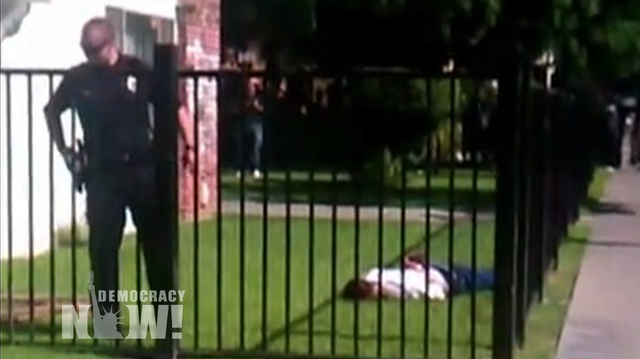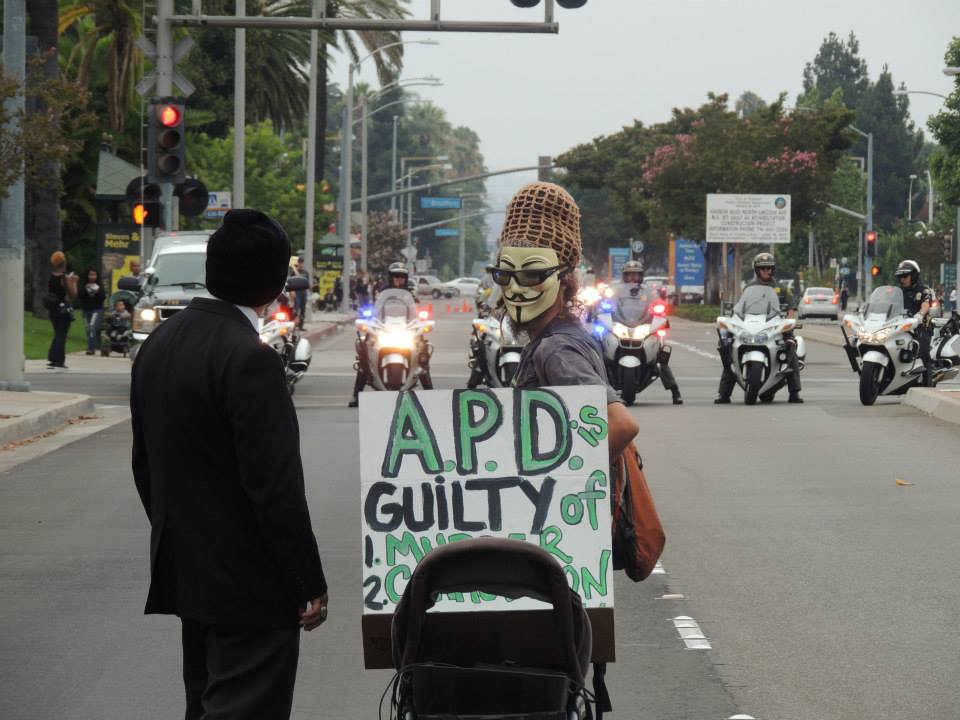Jury Decides Running From a White Anaheim Cop was No Reason to Murder Unarmed Latino Man but Discounts the Value of His Life

From [OCRegister] and [MORE] The family of a man killed by Anaheim police in a 2012 shooting that helped ignite riots in the city will receive $200,000, a federal jury determined on Friday, a day after it ruled the officer used excessive force.
The same jury that determined Officer Nick Bennallack used excessive force when he shot Manuel Diaz, 25, opted to award Diaz’s family far less than the $11 million the family’s attorney had suggested.
Outside the Santa Ana federal courthouse, Diaz’s mother, Genevieve Huizar, said she was happy the jury had found that her son was the victim of excessive force.
“It means the world to me,” Huizar said. “I was waiting a long time for this verdict. Being that they found him guilty, it relieves so much stress after the five years of going through this.”

Dale Galipo, the lead attorney representing Huizar, acknowledged that he was dissapointed in the monetary figure the jury arrived at, but described the trial as a victory for the civil rights community.
“Someone has to police the police,” Galipo said. “We respect the police. We know they have an important job. But there (has) to be some boundaries on the amount of force they can use. … We believe a verdict like this is extremely important in letting people know there will be accountability.” [there is no accountability. cops pay nothing out of pocket- taxpayers pay].
Galipo said what made the case “unique” was Bennallack and his partner Officer Brett Heitmann were not responding to a specific service call when they spotted Diaz standing outside a car in an alley near 700 North Anna Drive.
“They don’t see any specific criminal activity,” Galipo said.
Diaz, however, started running when he saw police. The officers shouted to him to stop, but he kept going into a courtyard, where he was gunned down before a fence.
The entire incident took about 10 seconds.
Bennallack testified he was concerned Diaz had a gun because his hands appeared to be near his waistband.
Diaz, however, started running when he saw police. The officers shouted to him to stop, but he kept going into a courtyard, where he was gunned down before a fence.
The entire incident took about 10 seconds.
Three teenage girl witnesses testified Diaz was shot twice — in the back and in the back of his head — with a pause between shots, Galipo said.
Galipo argued that the officers had to see a gun or fear there was an “imminent threat” of danger to them before opening fire and that wasn’t the case in this instance.
The officers also did not warn Diaz they would shoot if he did not stop, Galipo said. It appeared Diaz could have been surrendering when he was shot, the attorney argued.
Video above of the immediate moments after police killed Diaz. In the video Diaz was still alive--and police stood there for over three minutes and did nothing. Instead, they seem more concerned with pushing witnesses away from the scene, the better to diminish the video quality of the footage, when they weren't actively trying to block the source from recording.
"He was shot in the back of the leg area, brought to his knees before being shot in the head ... it was an execution-style shot," said attorney Diana Lopez. "There is no evidence of any kind of weapon. ... You can see the two officers walking around looking for something instead of attending to the young man who is near to his last breath," she said referring to a bystander's video that captured the post-shooting scene [MORE].
In a statement released after the jury’s Friday decision, city officials thanked the jurors “for their time and consideration.”
“Anaheim has come a long way since 2012, and for the family and all involved we are happy to see this phase come to a close,” Anaheim spokesman Mike Lyster said in the statement. “We offer best wishes to all as we move forward.”
On Friday morning, Galipo suggested that jurors award $4 million for the death of Diaz, $2 million for his mother’s loss over the past five years since the shooting and $5 million for her future loss.
Galipo acknowledged to jurors that Diaz was a gang member and a methamphetamine user. But he noted that despite Diaz’s problems, he had maintained a close relationship with his mother.
“Was he perfect? No,” Galipo told the jury on Friday morning. “I’ve yet to meet the perfect person. But we love and care for them anyway. We don’t say their lives have no value because of some imperfections.”
Galipo said Diaz’s decision to run from police the day he was shot was likely because of the methamphetamine found in his system. The attorney also said that Diaz’s drug problems were the reason he spent four years collectively behind bars, beginning at age 17.
“That is something that people can get through,” Galipo said of drug addiction.
Steven Rothans, an attorney representing the city, had countered that jurors should consider awarding $150,000 to $200,000 in damages, which he said would be “life-changing money.”
“Mrs. Huizar had already lost her son,” Rothans told the jury. “She lost him to drugs, she lost him to gangs, she lost him to imprisonment. … She lost him years before.”
The brief police chase that ended with Diaz’s death began after Bennallack and another officer spotted him leaning into a car in an alley on Anna Drive. Believing Diaz was involved in a drug deal, the officers got out of their unmarked car and chased after Diaz as he ran into an adjacent apartment complex.
Galipo said that Bennallack overreacted by shooting an unarmed Diaz in the back. The city’s attorneys said the shooting wouldn’t have happened if Diaz hadn’t run and ignored commands.
Diaz’s death following several other officer-involved shootings and touched off days of unrests and protests in Anaheim, culminating with a riot in the downtown area.
The Orange County District Attorney’s Office cleared Bennallack of any criminal wrongdoing. He remains an active-duty officer for the city.
The trial was held in two phases: the first in which jurors were provided the information known to Bennallack at the time of the shooting to determine if he used excessive force, and the second with more information introduced about Diaz’s background to determine how much his family should receive for his death.
Attorney’s for the city during the first phase were able to introduce information about the Anna Drive area, a neighborhood claimed by the city’s most active street gang. But the jury wasn’t told about Diaz’s gang ties or drug use until the second phase.
The city still faces the prospect of paying the Diaz family’s attorneys fees. Galipo noted that at least seven attorneys worked on two related federal trials and an appeals process, meaning the bill could reach $2 million. A judge will make the final decision on how much the attorneys get.
While Bennallack was named as a defendant in the case, he is not personally liable for the damages. Asked how the city would pay for the damages, Lyster said: “In the best interest of our residents, we plan for legal costs and participate in a risk-sharing pool with other cities to address situations like this.”